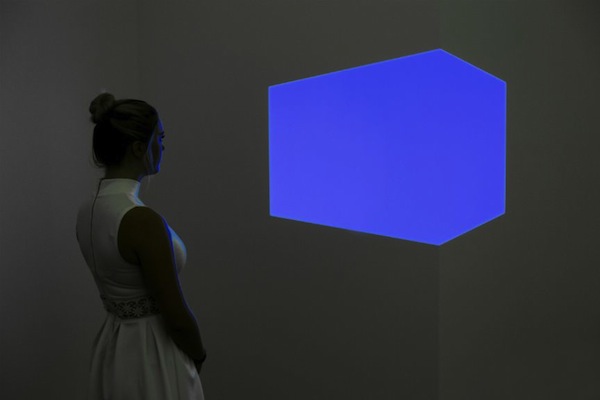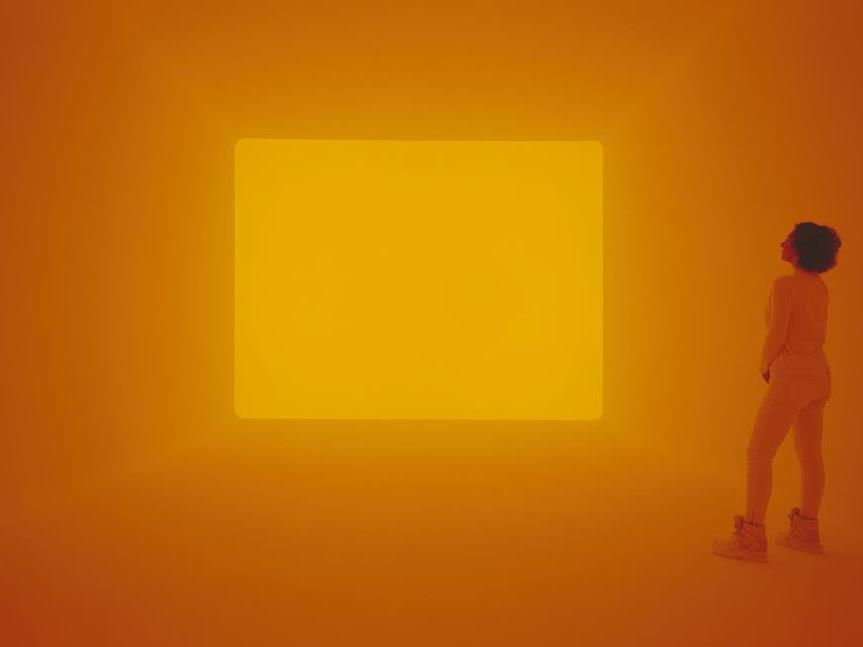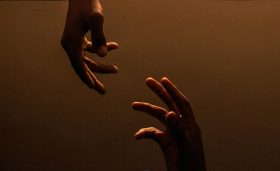Showing until 8 June, experience Turrell’s Ganzfeld at the NGA; Photo: Florian Holzherr
This is not an easy exhibition; but then being brave, bold and a boundary rider was never promised to be easy.
While we all like the sensorial fun-fair that light art can offer, this exhibition pulls the hype and pop back to its historical roots and more subtle expressions.
Coming to the National Gallery of Australia (NGA) after iterations in Los Angeles, Houston and New York, James Turrell: A Retrospective covers five decades of the American artist’s career and reasserts his position as one of the most important artists working in our times.
Why Canberra? The NGA have been nurturing a relationship with Turrell, which is framed around the connection between a local familiarity for the clarity of Canberra’s skies and light in sync with Turrell’s life’s work in the Arizona desert.
This major exhibition (along with a swag of purchases that preceded it) appropriately complements the Gallery’s outdoor installation, Skyspace within, commissioned in 2010, now beautifully “grown into” its environment.
Overall, there are six major room-size projections and light constructions in the show additional to the later more technically layered pieces – the unique Ganzfeld commissioned for the NGA show and the orb-environment Bindu Shards – ambitious by any curatorial endeavor.
These are complemented by Turrell’s prints and drawings from the start of his career in the mid 1960s, a handful of holograms, and marquettes for Turrell’s large environmental projects, including ephemera from his iconic Roden Crater project.
Turrell explained in a video documentation about his life’s work: ‘We drink light. If you use light to tell a story you are not talking about light, you are talking about the story…These things are your discovery that is what I like to unfold. It is something you have to discover yourself.’
NGA has been true to Turrell’s directive; but as audiences are we?
Some may argue that the very nature of this exhibition doesn’t translate well to the white cube. Turrell’s work is slow, and today largely audiences are not. But it is spending time with these light works that the rewards are dealt. Time makes us part of his artistic practice.
The visitor experience of the exhibition is clearly dominated by Turrell’s Ganzfeld: Virtuality Squared (2014), where viewers are drawn into a light-filled room drawn by its aperture of shifting colour.
Part of the experience is to don on protective booties and ascend a stair, building anticipation and the viewers sense of immersion in this piece. The edges of the room are curved so that the point of transition is diffused, creating what NGA Curator Lucinda Ward described as a ‘feeling of wondrous nothingness’.
‘If you have no image, no object, no place of focus, what do you have left? For me it then takes you to this primal relationship with light,’ Turrell said. His Ganzfeld’s are usually ephemeral works created for a specific site and moment. The catalogue explained their origins: ‘Ganzfeld is from the German for ‘entire’ or ‘complete field’ is a sensory deprivation technique designed to enhance extra sensory perception, it was pioneered in the 1930s and revived in the 1970s.’
While the spectacular Ganzfeld steals the limeline, is it the historical foundations of this exhibition that are mind blowing in comparison.
In 1966 Turrell rented a room in the Mendota Hotel in Santa Monica, sealing off the rooms to create light responsive environments – this is the stuff of art history lectures – what followed was Afrum (White), 1966, the cornerstone of his career.
It is presented, along with the Mendota studies, and later projections Shanta II (blue), 1970, Raemar pink white, 1969, and Joecar (red), in a rare moment to see this history aligned in one exhibition.

Shanta II (blue), 1970; image source artsreview.com.au
Shanta II (blue) 1970 and Afrum (White) 1966 are both forms created simply by projected light. It is a fabulous reminder to us today, how the sharpness and engagement that a form can have in active conversation with the viewer benign of the fancy technology that we have become so reliant on today.
Presented adjacent in a long corridor-like gallery are Turrell’s aquatints. Two series face each other in negative positive conversation; First light 1989-90 is described as a graphic index of his earlier projection works (purchased in 2013), and opposite it is Still light 1990-91 (purchased 2014).
They are simply divine. For anyone that has a penchant for printmaking, they will be blown away but Turrell’s technical control, witness to the bite of the acid bath on the plate. A standout is General site plan Roden Crater (1986), for its texture, tone and scale.
I have not mentioned Turrell’s Perceptual Cell: Bindu Shards (2010), an orb-shaped installation that sits central to the gallery you enter the exhibition. This is a clumsy room architecturally and it really doesn’t work that well from a curatorial perspective. However, the laboratory like spectacular of Bindu Shards – attended by two in lab coats monitoring an elaborate digital screen – adds weight to the perception of scientific verification.

Not for the faint-hearted, Bindu Shards (2010) is an intense strobe LED experience; image source www.designdaily.com.au
Did the piece work, aesthetically? Well its viewing sessions were sold-out the moment they were released online. And while I thank the NGA for their generosity with an early Sunday morning viewing of this piece for this review, I am less convinced the pomp of the piece delivers.
The viewer is projected into the orb upon a bed – not unlike a cat scan – and is then exposed to a 10-minuted cycle of rapid strobe and pulsations of colour. Perhaps I am missing the tension of the experience; the optical and perceptual challenge it imparted?
Overall this exhibition is largely for the converted. It is a sophisticated premise and it demands a certain commitment from the viewer. That is not bad; rather it should be championed across the breadth of a gallery’s programming, which so often today is driven by popularist, attendance-driving shows.
I suppose walking away from this exhibition it was that question of commitment that lingered. I noted a large number of the artworks had been collected by the Gallery in the last year (a cynic might ask if this part of the exhibition deal?) making it the largest holdings of Turrell’s work in the Southern Hemisphere.
Dated as 2014 acquisitions were Turrell’s aquatint series Still light (1990-91), the projection / constructions Joecar (red), Shanta II (blue), Orca, After Green, and yes the centrestage piece of the exhibition, Bindu Shards. Now that is some bill!
You have to salute the NGA’s persistent commitment to the American artist’s vision. And while Turrell’s work sits comfortably within the Gallery’s International Collection, and makes loose connections with Canberra’s light, one might ask how Turrell’s work has stimulated a dialogue with Australian artists and audiences?
Perhaps in the future we may see some of these new acquisitions curated into a conversation with light works by Australian artists in the Gallery’s Collection.
Undoubtedly, Turrell is an important artist of our time, both from the perspective of light art and land art. And despite any flaws or comments that might circulate around this exhibition, this is a show that warrants the trip to Canberra.
It’s high points are higher than your most hoped expectations. It’s a definite recommend.
Rating: 4 out of 5
James Turrell: A Retrospective
National Gallery of Australia until 28 June





